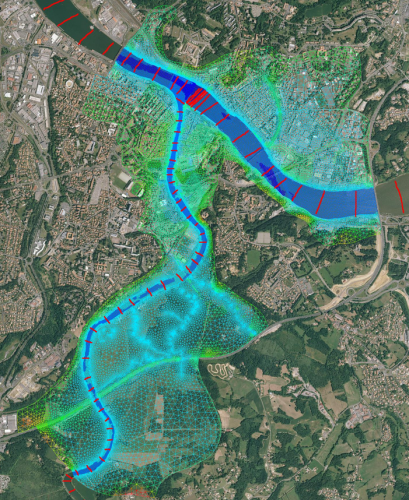
Couplage multi-dimensionnel 1D/2D en hydraulique, avec assimilation de données sur le bassin versant de l'Adour. PhD S. Barthélémy, 2015
What is DAMP ?
Developed in collaboration between CERFACS, the French hydroelectric power company EDF R&D and the French hydrometeorological flood forecasting center SCHAPI, DAMP (Data Assimilation with Mascaret Prototype) is a data-driven river hydrodynamic simulator dedicated to real-time flood forecatsing. DAMP is based on the MASCARET 1-D hydraulic solver (shallow water equations) and on the sequential assimilation of in-situ water level and discharge data.
The platform is implemented with the dynamic coupling software OpenPALM that allows for an optimal management of computational resources and communication between the physical model and the Kalman filter data assimilation algorithm.
DAMP as of today
The assimilation algorithm enables for the correction of hydraulic parameters (friction coefficient), hydrological forcing as well as hydraulic state and leads to the improvement of the forecast at short to medium lead-times. As of today, DAMP is used operationally at SPC SAM (Seine Amont Marne Amont) and currenlty being implemented at SCHAPI with in the POM (Plate-forme Opérationnelle de Modélisation) for a broader use on French catchments. #environmental risk #vigicrues #flood forecasting #hydrodynamics #data assimilation #mascaret

Water level forecast improvement with DAMP for the Marne catchment (April 2006 event at Joinville). The model without data assimilation over estimate the flood peak (black curve). The analysis with DAMP (red curve) is closer to the observation (blue curve).
DAMP in the future
At research level, efforts are currently made at CERFACS to extend DAMP to ensemble-based data assimilation strategies with the following functionalities:
- data possibly being in situ or spaceborne (SWOT mission);
- the hydraulic solver being 1-D (MASCARET) or 2-D (TELEMAC);
- combining data assimilation with uncertainty quantification techniques to reduce the cost of the data assimilation algorithm;
- applying data assimilation to a coupled 1-D/2-D hydraulic solver to account for 2-D flows (e.g. river confluence) at reduced cost.

